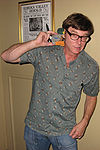The Cartoon Portal

A cartoon is a type of visual art that is typically drawn, frequently animated, in an unrealistic or semi-realistic style. The specific meaning has evolved, but the modern usage usually refers to either: an image or series of images intended for satire, caricature, or humor; or a motion picture that relies on a sequence of illustrations for its animation. Someone who creates cartoons in the first sense is called a cartoonist, and in the second sense they are usually called an animator.
The concept originated in the Middle Ages, and first described a preparatory drawing for a piece of art, such as a painting, fresco, tapestry, or stained glass window. In the 19th century, beginning in Punch magazine in 1843, cartoon came to refer – ironically at first – to humorous artworks in magazines and newspapers. Then it also was used for political cartoons and comic strips. When the medium developed, in the early 20th century, it began to refer to animated films that resembled print cartoons. (Full article...)

In print media, a cartoon is a drawing or series of drawings, usually humorous in intent. This usage dates from 1843, when Punch magazine applied the term to satirical drawings in its pages,[1] particularly sketches by John Leech.[2] The first of these parodied the preparatory cartoons for grand historical frescoes in the then-new Palace of Westminster in London.[3]

Selected article -
The Ren & Stimpy Show, often simply referred to as Ren & Stimpy, is an American animated television series, created by Canadian animator John Kricfalusi. The show premiered on August 11, 1991, on Nickelodeon as part of its Nicktoons block along with Rugrats and Doug. The series focuses on the titular characters: Ren Höek, an emotionally unstable chihuahua, and Stimpson J. Cat, a good-natured, dimwitted cat. The show ran for five seasons on the network, received critical acclaim, and developed a cult following during and after its run. Some critics credit it along with The Simpsons for leading the way for satirical animated shows like Beavis and Butt-head and South Park, and for playing a significant role in television animation. Throughout its run, The Ren & Stimpy Show was controversial for its off-color humor, sexual innuendo, and violence which were rare for television animation of the time. This controversy contributed to the production staff's altercations with Nickelodeon's Standards and Practices department. A spin-off for adult audiences, Ren & Stimpy "Adult Party Cartoon", aired in 2003 on Spike, but was cancelled soon after its debut.
Selected character -
Batman (originally referred to as the Bat-Man and still sometimes as the Batman) is a DC Comics fictional superhero who first appeared in Detective Comics #27 in May 1939. He has since become, along with Superman and Spider-Man, one of the world's most recognized superheroes. Batman was co-created by artist Bob Kane and writer Bill Finger, although only Kane receives official credit for the character. Batman's secret identity is Bruce Wayne, billionaire industrialist, playboy, and philanthropist. Witnessing the murder of his parents as a child leads him to train himself to the peak of physical and intellectual perfection, don a costume, and fight crime. Unlike most superheroes, he does not possess any superhuman powers or abilities; he makes use of intellect, detective skills, technology, and physical prowess in his war on crime.
Did you know... -
- ...that 1999's Scooby-Doo! Mystery of the Fun Park Phantom was the first commercial Scooby-Doo computer game for the Windows platform?
- ...that the Fire Nation, from the Universe of Avatar: The Last Airbender, was inspired by photos of volcanic islands of Iceland and the Pacific Ocean?
- ...that the Sam Sheepdog and Ralph Wolf cartoons Sheep Ahoy, A Sheep in the Deep, and Don't Give Up the Sheep were censored by ABC to remove a dynamite stick, a smoke break scene, and a spanking scene respectively?
- ...that Sozin's Comet: The Final Battle, the two-hour finale for Avatar: The Last Airbender, was the most-watched cable television broadcast in the week of its transmission?
Selected list -
There have been 131 episodes of Ed, Edd n Eddy, an animated comedy television series created by Danny Antonucci and produced by Canada-based a.k.a. Cartoon. The series debuted on Cartoon Network in the United States on January 4, 1999, and ended on November 8, 2009, with the premiere of the series finale film Ed, Edd n Eddy's Big Picture Show. The series was originally planned to air for four seasons; however, Cartoon Network ordered two additional seasons and three holiday-themed specials as a result of its popularity. Reruns continue to air on Cartoon Network, including airing as part of the revived block Cartoon Planet. The series revolves around three adolescent boys collectively known as "the Eds", who live in a suburban cul-de-sac. Unofficially led by Eddy, the Eds constantly try to scam the fellow cul-de-sac children in order to purchase jawbreakers. The Eds' plans usually fail and leave them in various predicaments. The award-winning series garnered generally positive reviews, and remains the longest running original Cartoon Network series and Canadian-made animated series to date.
General images -
Selected biography -
Steve Ross Purcell is an American cartoonist, animator and game designer. He is most widely known as the creator of Sam & Max, an independent comic book series about a pair of anthropomorphic animal vigilantes and private investigators, for which Purcell received an Eisner Award in 2007. The series has since grown to incorporate an animated television series and several video games. A graduate of the California College of Arts and Craft, Purcell began his career creating comic strips for the college newsletter. He performed freelance work for Marvel Comics and Fishwrap Productions before publishing his first Sam & Max comic in 1987. Purcell was hired by LucasArts as an artist and animator in 1988, working on several titles within the company's adventure games era. Purcell collaborated with Nelvana to create a Sam & Max television series in 1997, and briefly worked as an animator for Industrial Light & Magic after leaving LucasArts. He is currently employed in the story development department at Pixar. His main work for the animation studio has been with the 2006 film Cars and spin-off materials such as shorts and video games. Despite his employment with Pixar, Purcell has continued to work with comic books and came together with Telltale Games in 2005 to bring about new series of Sam & Max video games.
Subcategories
WikiProjects
- Main projects
- Arts • Animation • Comics • Entertainment • Visual arts
- Related Projects
- Anime and manga • Biography • Film • Fictional characters • Media franchises • Music • Television • Video games
Selected quote -
Topics
- Comic book
- Comic strip
- Digital comics
- Graphic novel
- Mobile comic
- Motion comics
- Trade paperback
- Webcomic
- Animator
- Animation director
- Animation studios
- Animation film festivals
- Feature-length films
- Short films
- Television series
- Computer-animated films
- Stop-motion films
- Traditional animation
- Limited animation
- Rotoscoping
- Stop Motion
- Clay
- Cutout
- Graphic
- Model
- Object
- Pixilation
- Puppetoon
- Computer animation
- Flash animation
- PowerPoint animation
- SVG animation
- Cel-shaded animation
- Crowd simulation
- Morph target animation
- Motion capture
- Non-photorealistic rendering
- Skeletal animation
Things you can do

- Requested articles: Fenwick (comics), Khimaera (comics), Mutant Underground Support Engine, Bruce J. Hawker, Marc Dacier, Hultrasson, Frankenstein Comics, Dave Johnson (comics), Paco Medina, Dappere Dodo, New Adventures of the Space Explorers, Habatales, Musical Box, Foo-Foo (TV series), Bonne nuit les petits, The Adventures of Lariat Sam, More...
- Images and photos needed: Request images that are needed from Wikipedia requested images of comics and animation to included in each articles.
- Stubs: Work on stubs in articles in Comics and Animation stubs.
- Infobox: Add infobox that are needed from Category:Comics articles without infoboxes and Category:Animation articles needing infoboxes in articles.
- Deletion sorting: Please see the collection of discussions on the deletion of articles related to comics and animation - compiled by WikiProject Deletion sorting
Related portals
Associated Wikimedia
The following Wikimedia Foundation sister projects provide more on this subject:
-
 Commons
Commons
Free media repository -
 Wikibooks
Wikibooks
Free textbooks and manuals -
 Wikidata
Wikidata
Free knowledge base -
 Wikinews
Wikinews
Free-content news -
 Wikiquote
Wikiquote
Collection of quotations -
 Wikisource
Wikisource
Free-content library -
 Wikiversity
Wikiversity
Free learning tools -
 Wiktionary
Wiktionary
Dictionary and thesaurus
More portals
Sources
- ^ Punch.co.uk. "History of the Cartoon". Archived from the original on 2007-11-11. Retrieved 2007-11-01.
- ^ Adler & Hill 2008, p. 30.
- ^ "Substance and Shadow: Original Editorial Accompanying "Cartoon, No. I"". Victorian web.org. Retrieved 29 October 2023.
Purge server cache































